How to Connect Signals to the NI PXI-2510 FIU
Overview
Contents
- Introduction
- Cabling Options for the PXI 2510
- Signal Connection with SH160DIN-3xDB50F Cable
- Signal Connections with SH160DIN-160DIN
- Signal Connections with SH160DIN-BARE WIRE Cable
- Third Party Terminal Block Options for the SH160DIN-3xDB50F Cable
- Related Resources
Introduction
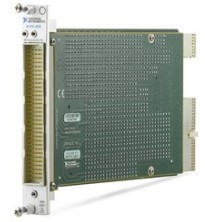
The NI PXI-2510 fault insertion unit (FIU) is designed for use in hardware-in-the-loop (HIL) applications and electronic reliability tests. Each module has a set of feedthrough channels, which when closed make the switch transparent to the system. You can open or short these channels to one of two fault buses, each of which offers a multiplexer with four possible inputs. You can use this architecture to simulate open or interrupted connections as well as shorts between pins, shorts to battery voltages, and shorts to ground on a per-channel basis. When controlled with the NI LabVIEW Real-Time Module, this FIU is ideal for validating the reliability of control systems such as engine control units (ECUs), full authority digital engine controls (FADECs), and more with up to 2 A loading conditions.
Cabling Options for the PXI 2510
NI offers three unique cables for connecting to NI PXI-2510: SH160DIN-3XDB50F, SH160DIN-160DIN, and SH160DIN-BARE WIRE. You’ll want to connect the either of these cables to the front of the NI PXI-2510, as shown below in Figure 2. For more details on how to get started with the DIN160 cable see the DIN160 Installation Instructions.
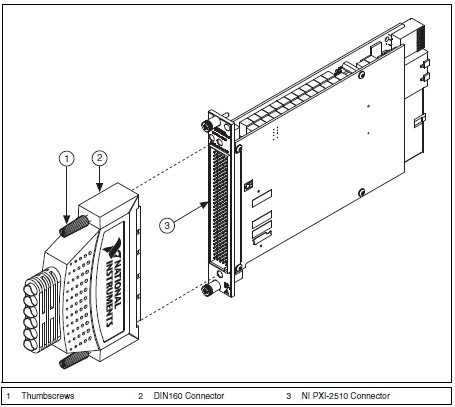
Signal Connection with SH160DIN-3xDB50F Cable
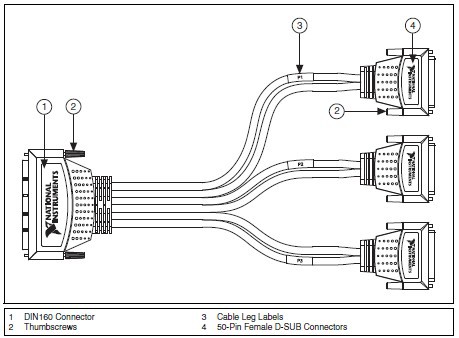
Fig 3: SH160DIN-3xDB50F Cable
To connect signals via the SH160DIN-3XDB50F, three NI TBX-50 or TBX-50B terminal blocks may be used. The NI TBX-50or TBX-50B terminal block is DIN rail-mountable with screw terminals to connect the signals to the switch and includes a probe socket and a 50 pin D-SUB male connector. This 50-pin D-SUB connector is shown below in Figure 4. To view the pin-out information for the SH160DIN-3XDB50F cable, please see the document attached to this article.
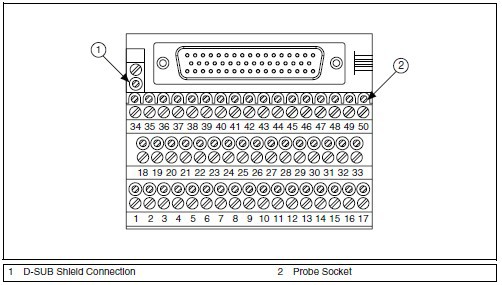
Using the cable options described above, connections are made between the three 50-pin TBX-50 or TBX-50B terminal blocks and the PXI-2510.
Signal Connections with SH160DIN-160DIN
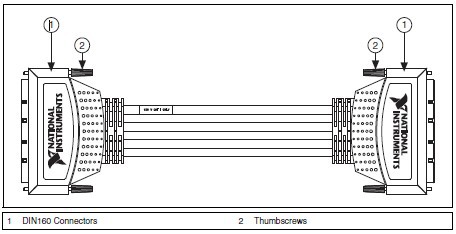
The SH160DIN-160DIN is recommended when you are connecting the PXI-2510 to a system that terminates with a male DIN160 connector. To view the pin out information for the SH160DIN-160DIN cable, please see the document attached at the end of this article.
Signal Connections with SH160DIN-BARE WIRE Cable
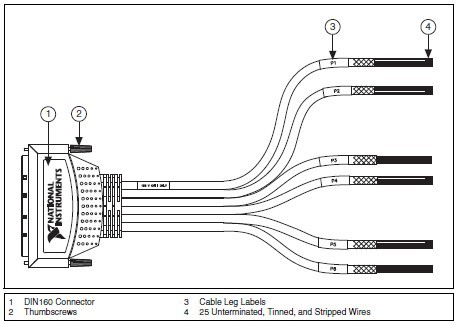
The SH160DIN-BARE WIRE cable is recommended for applications that cannot connect to either the 50-pin female D-SUB connector or the DIN160 connector. Shown in the picture above, one side of the cable terminates with a DIN160 connector, and the other end of the cable has six bundles of unterminated, tinned, and stripped wires. To view the pin out information for the SH160DIN-BARE WIRE cable, please see the document attached at the end of this article.
Third Party Terminal Block Options for the SH160DIN-3xDB50F Cable
Using the SH160DIN-3xDB50F cable described above, signal connections can be made to screw terminals on a 50 pin terminal block from third party vendor. Terminal blocks from third party vendors are listed in the table below:
Accessory
| Manufacturer
| Part Number
|
VARIOFACE module, with screw connection
and 50 position D-Subminiature pin strip | FLK-D50 SUB/S
| |
VARIOFACE module, with screw connection
and 50 position D-Subminiature pin strip | FLKM-D50 SUB/S | |
VARIOFACE module, with screw connection
and 50 position D-Subminiature pin strip | FLKMS-D50 SUB/S
| |
VARIOFACE module, with screw connection
and 50 position D-Subminiature pin strip, with LED indicators | FLKM-D50 SUB/S/LA
|
